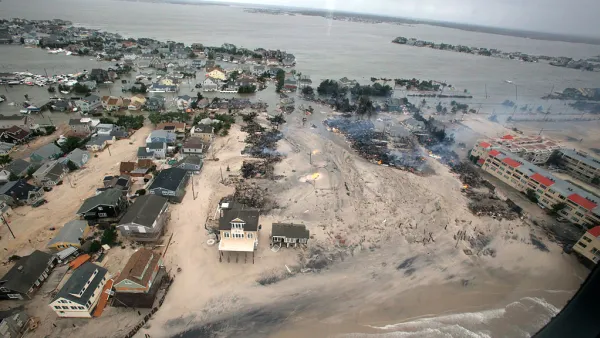After nearly a decade of ignoring warnings about the type of disaster witnessed this week, New York City and State officials may no longer be able to push off implementing drastic plans to safeguard the city from rising seas and super storms.
David W. Chen and Mireya Navarro consider the options for "major infrastructural changes" available to public officials as they confront the reality that what were once considered "100-year" storms may now occur fairly frequently.
"Gov. Andrew M. Cuomo said the state should consider a levee system or storm surge barriers and face up to the inadequacy of the existing protections," report Chen and Navarro. "The Cuomo administration plans talks with city and federal officials
about how to proceed. The task could be daunting, given fiscal
realities: storm surge barriers, the huge sea gates that some scientists
say would be the best protection against floods, could cost as much as
$10 billion."
"Under a proposal put forth by the Storm Surge Research Group
at Stony Brook University in 2004, large portions of the city could be
protected by three movable barriers installed at the upper end of the
East River near the Throgs Neck Bridge, under the Verrazano-Narrows
Bridge and at the mouth of the Arthur Kill between Staten Island and New
Jersey."
"Still," say Chen and Navarro, "some experts consider the barriers a last resort, and urge more modest changes, including subway floodgates."
Despite the renewed focus on the need to plan for disaster prevention, and not just response, "[w]hat scientists, who have devoted years of research to the subject, now
fear most is that, as soon as the cleanup from this storm is over, the
public will move on."
FULL STORY: For Years, Warnings That It Could Happen Here

National Parks Layoffs Will Cause Communities to Lose Billions
Thousands of essential park workers were laid off this week, just before the busy spring break season.

Retro-silient?: America’s First “Eco-burb,” The Woodlands Turns 50
A master-planned community north of Houston offers lessons on green infrastructure and resilient design, but falls short of its founder’s lofty affordability and walkability goals.

Delivering for America Plan Will Downgrade Mail Service in at Least 49.5 Percent of Zip Codes
Republican and Democrat lawmakers criticize the plan for its disproportionate negative impact on rural communities.

Test News Post 1
This is a summary

Test News Headline 46
Test for the image on the front page.

Balancing Bombs and Butterflies: How the National Guard Protects a Rare Species
The National Guard at Fort Indiantown Gap uses GIS technology and land management strategies to balance military training with conservation efforts, ensuring the survival of the rare eastern regal fritillary butterfly.
Urban Design for Planners 1: Software Tools
This six-course series explores essential urban design concepts using open source software and equips planners with the tools they need to participate fully in the urban design process.
Planning for Universal Design
Learn the tools for implementing Universal Design in planning regulations.
EMC Planning Group, Inc.
Planetizen
Planetizen
Mpact (formerly Rail~Volution)
Great Falls Development Authority, Inc.
HUDs Office of Policy Development and Research
NYU Wagner Graduate School of Public Service



























